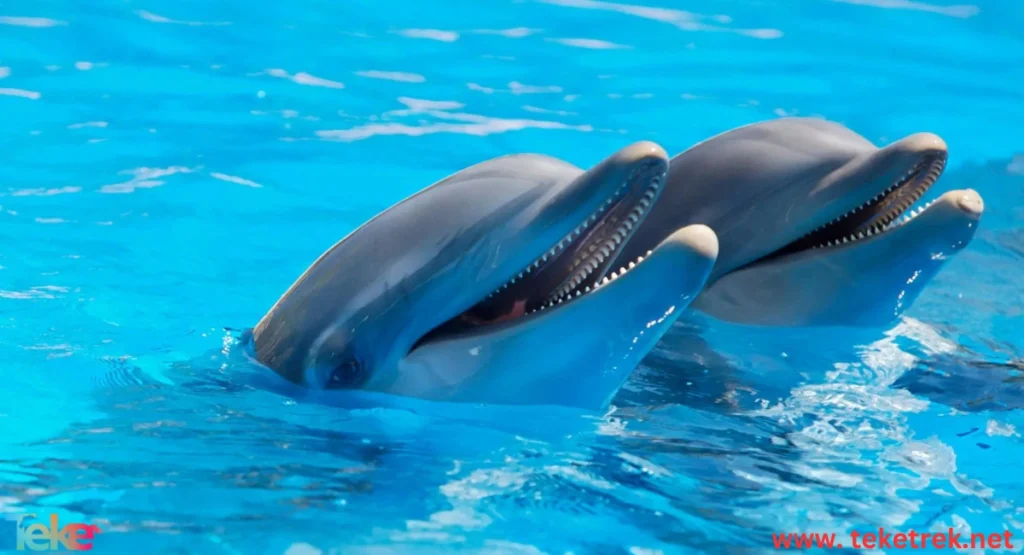Dolphins are a type of marine mammal known for their intelligence and interaction with humans. They possess distinctive sounds and playful movements. Generally, dolphins have advanced communication skills and are capable of recognizing themselves in mirrors, indicating self-awareness and superior cognitive abilities. Moreover, dolphins demonstrate planning, cooperation, and group hunting, making them some of the most studied and beloved marine creatures worldwide. Bottlenose dolphins are found in large numbers in the Atlantic Ocean near the coast of Key West, attracting tourists from around the world who come to see and play with them. Here are the details in this article from teketrek.
How Do Dolphins Use Sounds to Communicate?
Dolphins use various sounds for communication, supported by their complex hunting systems and social behaviors. They emit a range of sounds to convey information within dolphin communities, including:
- Clicks and Echolocation: Dolphins produce a series of clicks that help them create a mental map of their surroundings, a process known as echolocation. These clicks assist them in navigation, prey detection, and identifying nearby marine creatures. The primary purpose of these clicks is to enable spatial awareness and readiness for hunting and movement. Dolphins can distinguish the size, shape, and distance of objects by emitting specific clicks, allowing them to pinpoint prey accurately and capture it efficiently.
- Whistles: Dolphins produce a tonal sound using their blowholes, with each dolphin having a unique whistle known as a “signature whistle” that represents the individual. Whistles are mainly used for communication within the group, helping maintain social bonds and coordinate activities. They also convey emotional states. Dolphins use signature whistles to recognize and call each other.

The Role of Body Movements and Social Interaction in Dolphin Communication
Dolphins perform many playful and amusing movements and interact rapidly with humans. They are creatures that enjoy laughing, playing, and leaping above the water surface. Dolphins communicate some information through their body language and social interactions, including:
- Body Movements: Dolphin body movements serve two main purposes. The first is to express intentions; dolphins use body language to reveal their internal intentions, feelings, and emotions. For example, dolphins swim side by side to show affection, and they “laugh” to each other expressing love and sharing play accompanied by additional clicks. The second purpose is to complement sounds, as dolphin communication extends beyond sounds to include body language and motions. Researchers have observed that dolphins have unique movements and sounds that are difficult to fully understand, enhancing their close social bonds and intelligence.
- Social Interactions: Dolphins form strong social bonds within their groups, including behaviors like swimming near their pod, touching, and vocalizations that signal companionship, cohesion, belonging, and group affinity. The main goal of social interactions is group welfare, strengthening relationships, cooperation, and group play. These social behaviors also demonstrate strength and assistance in hunting prey and offer protection against ocean predators. They promote messages of unity and group cohesion.
Your Comprehensive Guide to African Grey Parrot Care | Characteristics, Behavior, and Food
Do Dolphins Have Their Own Language?
Dolphins possess a unique vocal language they use to express interactions and information within large dolphin groups. Their communication relies on sounds and body movements, including:
- Emitting sounds such as whistles and clicks to sense their environment and communicate within the group. Dolphins use echolocation to locate themselves and their surroundings. Whistles and clicks are also used to communicate with other dolphins of the same or different species.
- The dolphin’s respiratory channel, similar to nostrils, contains several valves used to generate ultrasonic waves by rubbing against the skull bones through special muscles. These ultrasonic waves travel directly into the water via the fatty tissues between the blowhole and the long snout that resembles a beak.

Summer Dog Care Guide: Heat Protection, Dehydration Prevention, and Parasite Prevention
Amazing Facts About Dolphin Communication With Humans
There are many fascinating facts about dolphins, as they are interactive marine creatures that love playing and communicating with humans through laughter, sounds, and movements. Notable facts include:
- A 2010 study by Hanger College showed that dolphins possess intelligence surpassing that of most other animals on Earth, ranking second only to humans. Dolphins can recognize themselves and learn specific movements and symbols that aid communication.
- A study published in the Proceedings of the National Academy of Sciences found that dolphins use unique signature whistles to call other dolphins by their “names,” similar to humans calling each other by names.
- Scientists have developed a “chat” program for remote hearing and measuring whale sounds, which is a computer that plays prerecorded dolphin whistles along with their own sounds at the push of a button. This tool is used by top dolphin scientists worldwide as an attempt to communicate with dolphins in the ocean.
Conclusion
Dolphins are among the most complex and fascinating marine creatures inhabiting oceans and seas. They are highly intelligent and possess remarkable abilities to interact with humans and communicate with other dolphin groups. Their communication depends on sounds and clicks that convey a wealth of information to other dolphins. Spectacular water shows featuring dolphins are enjoyed by audiences worldwide. Dolphins also play a vital ecological role by preying on weak or sick fish and cleaning the oceans of incomplete crustaceans, thus helping maintain marine life balance.





